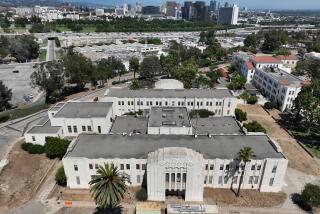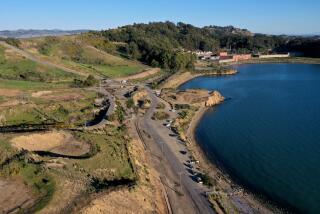Camarillo Protest : Group Acts to Halt Funds for Guard’s Move
- Share via
Camarillo residents who opposed the planned transfer of an Air National Guard unit from Van Nuys to Point Mugu have launched a campaign to block federal funding for the move.
About 60 opponents of the transfer met Friday night at the Camarillo Library to mobilize support for a campaign to persuade congressional budget writers to withhold funds for the transfer.
The group received support from Ventura County Supervisor Ed Jones. A letter read to the group by one of Jones’ aides called the proposed move “unnecessary, unwanted and environmentally unsound.”
The meeting was the latest round in a two-year dispute over the future of the 146th Tactical Airlift Wing.
Camarillo residents and the city’s government want to prevent the guard wing from moving to the Naval Air Station at neighboring Point Mugu, charging that it would cause traffic, safety and air pollution problems. Palmdale and Lancaster, meanwhile, have been trying to attract the unit to their area as an economic asset.
The Air Force, after years of dispute, ruled in November that the wing would move to Point Mugu.
However, continuing political opposition has temporarily suspended the initial steps needed for the move. Six Southern California members of Congress succeeded in freezing the $5-million appropriation needed to buy land for the wing at Point Mugu, although the money was approved in the current federal budget.
Pressure in Washington
Elected officials of the three cities made a lobbying visit to Washington in December. Afterward, the six congressional representatives wrote Rep. W.G. (Bill) Hefner, D-N.C., chairman of the military construction subcommittee of the Appropriations Committee. They asked that Hefner instruct the Air Force not to spend the money “until this whole thing can be restudied by the committee,” said Paul Clarke, executive assistant to Rep. Bobbi Fiedler, R-Northridge.
Fiedler signed the letter, along with Reps. William Thomas, David Dreier, Jerry Lewis, Carlos J. Moorhead and Robert K. Dornan. All are California Republicans.
Hefner’s staff reported that “the move is on hold” for the time being, Clarke said.
The freeze raised the possibility that the House committee could use its power over the budget process to press the Air Force to change its decision, if members of the military construction subcommittee can be persuaded that it would make more economic sense to send the wing to the Mojave Desert, Clarke said.
County Enters Fray
Although the City of Camarillo has long opposed the Point Mugu choice, Jones’ letter was the first support from the county government level. Jones wrote that he did “not believe there are any possible benefits to moving the Air Guard to Point Mugu that in any manner outweigh the negative impacts on our community.”
Jones said he does not believe the reasons given for the Point Mugu choice, saying “the real reason for their proposed move here is that the officers would rather live in Ventura County than in the Palmdale area.”
The 1,500-person air wing, the largest of its type in the nation and the oldest unit in the California Air National Guard, has been looking for a new home for years. The federal government’s $1-a-year lease on the unit’s base in Van Nuys expired last year and, the wing’s officers say, for many years, the Van Nuys Airport has been too crowded for military style flying.
When the search for a new base narrowed to two leading candidates--Point Mugu and Palmdale--the three cities mounted an intense campaign, lobbying the governor’s office and state and federal legislators. All three argued that the Mojave Desert location would save millions of dollars and provide other benefits.
Air Force Land
The wing could be housed on land already owned by the Air Force at Air Force Plant 42 in Palmdale, avoiding the need to buy land at Point Mugu, they said. The salty ocean air at Point Mugu would cause maintenance problems that would not occur in the desert atmosphere, Palmdale’s proponents alleged. They also maintained that the coastal fog at Point Mugu causes problems for pilots whereas the air is usually clear in the desert.
Because the wing carries out much of its military practice in the Antelope Valley anyway, they argued, it would be cheaper to base aircraft there, rather than fly them 65 miles from Point Mugu at a cost of about $3,000 per hour of flying time.
Housing costs for the wing’s 300 full-time members would be cheaper in the Antelope Valley, supporters argued, adding that a pro-military atmosphere, brought about by the many aerospace factories and military bases in the area, would be good for the wing’s morale.
The wing’s officers originally said they favored the move to Point Mugu because it would give them a better pool of recruiting-age youths. However, the Air Force official who chose Point Mugu cited another reason.
Deal With Los Angeles
When the official, James F. Boatright, deputy assistant secretary of the Air Force, met with representatives of the three cities, he told them the Air Force does not want to add military units to Air Force Plant 42 because of an agreement signed in November with the City of Los Angeles.
Under terms of the pact, the Air Force and the city agreed to convert Plant 42 into a joint civilian-military airfield, to be named Palmdale Regional Airport. The city, in turn, pledged not to construct a new airport in the area until the Palmdale Regional Airport is operating at full capacity, which is expected to be many years in the future--if ever.
The Department of Defense has long opposed Los Angeles’ plans to build an airport on city-owned land in Palmdale. The Pentagon feared such an airport would attract heavy commercial airliner traffic that would interfere with flights from Edwards Air Force Base and other military air bases in the area.
Consequently, Boatright told the cities’ representatives, the Air Force’s “overriding consideration . . . is to protect the capacity at Air Force Plant 42 for commercial use by the Los Angeles airport authority because the Department of Defense does not want a Los Angeles city airport built nearby.”
More to Read
Sign up for Essential California
The most important California stories and recommendations in your inbox every morning.
You may occasionally receive promotional content from the Los Angeles Times.










